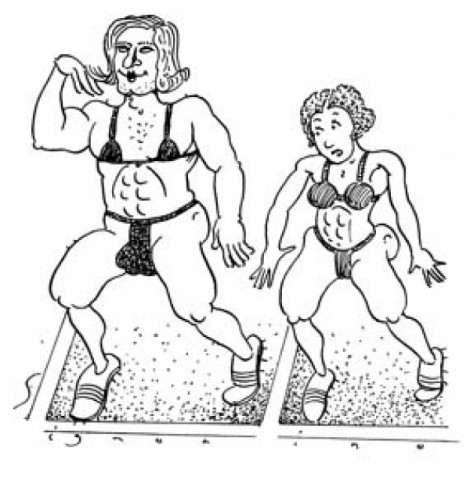
If a man has a sex change, can he compete in the Olympics as a woman? —Stephanie Ketchum
In our enlightened age, when science has made it possible to be the sex you feel like rather than the one nature stuck you with, some think it stuffy to insist on doing things the old-fashioned way. Why not let transsexuals compete as the sex they change to? Obvious rejoinder: Because it’s no fair letting a hulking genetic male go up against smaller genetic females just because he now calls herself Kathy. But as always it’s not that simple.
There’s a history of men sneaking into women’s sports, typically ordinary guys trying to take advantage. One was German high jumper Hermann Ratjen, who competed in the 1936 Olympics under the name Dora Ratjen, placing fourth. (In a confession two decades later he claimed the Nazis made him do it.) Soviet gold medal-winning sisters Tamara and Irina Press, sometimes called “the Press brothers,” were widely suspected of being males in disguise, as were several other 1960s athletes.
The last straw was North Korea’s Sin Kim Dan, who was riding high in 1964 after breaking the world records for the 400- and 800-meter runs—until her father came forward, recognizing his long-lost son. Determined not to be embarrassed again, the International Association of Athletics Federations (IAAF) required women athletes to submit to a physical exam to prove their femaleness for the 1966 European track and field championships. The exam was a ludicrous procedure that involved parading en masse past three female gynecologists. Nonetheless, Time noted snarkily at the time, the Press sisters and several other female athletes decided to drop out of the competition.
The visual exam gave way to mandatory lab testing in time for the 1968 Olympics; DNA testing was introduced for the 1992 Winter Games. Blanket gender testing for the Olympics was abolished in 1999, although testing can still be done in questionable cases. As far as anyone knows, no men have snuck by recently.
But cheaters aren’t our concern here. You were asking about genetically male athletes who believe they are, or ought to be, female.
Genetically anomalous athletes are rare but not unknown. Testing for the 1996 Olympics revealed that 8 of 3,387 female athletes had genetic makeups that, by some definitions, made them male. Some women athletes have an XY chromosome pair that makes them genetically male but suffer from androgen-insensitivity syndrome, meaning their external sex characteristics are, for the most part, female. Example: champion Spanish hurdler Maria Martinez Patino, who was disqualified from a 1985 competition by genetic tests but eventually reinstated when she protested. One nominally female athletic star apparently was a hermaphrodite. Polish Olympic champion Stanislawa Walasiewicz (known as Stella Walsh in the U.S., where she spent most of her life) won the women’s 100-meter run in the 1932 games and picked up the silver in that event in 1936. On autopsy following her death in 1980—she was killed by stray gunfire during an attempted robbery—she was found to have sexually ambiguous genitalia resulting from a chromosomal abnormality known as mosaicism.
That brings us to transsexual athletes. Most often they’re normal genetic males who identify as female and want to compete as women. Tennis pro Renee Richards is perhaps the best-known case because of the fuss she made after being barred from the 1976 U.S. Open, eventually resulting in a court decision in her favor.
In 1990, the IAAF became the first major international sports body to recommend transsexuals to compete against their new peers. The International Olympic Committee followed this advice starting with the 2004 Athens games, with some restrictions. Most of these are common sense: Athletes who have sex-reassignment surgery before puberty are automatically accepted as their new sex, while those who wait until after puberty must have all surgical changes completed, be legally recognized as their new sex in the country they represent, and have had hormone therapy for an extended period of time.
We haven’t heard the last of the argument. Some wonder how the IOC can crack down on performance-enhancing drugs while allowing “transathletes” to take hormones. The objection is specious, in my opinion; most banned drugs are intended to give you an unfair advantage, while female hormones are meant to make a possible unfair advantage go away. Still, medical advances have given sports officials some tough calls, and not just where gender is concerned.
Comments, questions? Take it up with Cecil on the Straight Dope Message Board, StraightDope.com, or write him at the Chicago Reader, 11 E. Illinois, Chicago 60611.